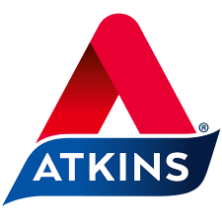Following a low-carb diet is suitable for everyone: For people who want to lose weight and those who want to maintain their weight and want to feel more energetic. Instead of simple, refined carbs you will eat more protein and fat to provide your body with energy. Starvation is absolutely not an option. On the Atkins website you will find the most delicious low-carb recipes and products. What about our recipe for a low carb pasta or our delicious cheesy low carb garlic bread.
- Home►Get inspired►Articles►low carb atkins diet
Low Carb Atkins Diet


Scroll directly down to
- What is a low-carbohydrate diet?
- What is Atkins and low-carb?
- Phase 1 - The induction phase
- Phase 2 - the phase where you continue your to lose weight
- Phase 3 - Pre-Maintenance
- Phase 4 - Lifetime Maintenace
- Fats and proteins
- Who is a low carb diet suitable for?
- Low carb meal plan
- Still need more inspiration?
- Start on Atkins today

- What is a low-carbohydrate diet?
- What is Atkins and low-carb?
- Phase 1 - The induction phase
- Phase 2 - the phase where you continue your to lose weight
- Phase 3 - Pre-Maintenance
- Phase 4 - Lifetime Maintenace
- Fats and proteins
- Who is a low carb diet suitable for?
- Low carb meal plan
- Still need more inspiration?
- Start on Atkins today
Would you like to immediately start to lose weight and / or feel fitter and more energetic? Start today with Atkins low-carb diet!
1. Enjoy more variety with delicious low carb recipes for you.
2. Gradually add more healthy carbohydrates as you go through the phases of Atkins.
3. Sugar cravings disappear and you can eat the delicious Atkins products.
4. Guidance and support, all for free!
Start on Atkins today and receive support, tips and meal plans for free!
Start now on Atkins
Start todayWhat is a low-carbohydrate diet?
A low-carb diet is a diet where you limit your intake of carbohydrates. The word diet suggests that you do this for a short period so we prefer to call Atkins a low carb lifestyle. Eating low carbs is not only for people who want to lose weight, but also for people who want to eat a healthy and varied diet. The daily carbohydrate intake we advise you depends on your goal and your personal carb balance.
Contents of this article
- Why is Atkins low-carb? (Explanation + Movie)
- The four phases of Atkins
- Carbohydrate intake for Phase 1
- Carb intake for Phase 2
- Carb intake for Phase 3
- Carb intake for Phase 4
- Fat and protein intake on Atkins
- Overview of the food you can eat on Atkins
- Low carb weekly menu
What is Atkins and low-carb?
To switch to a low-carb lifestyle it's important to know what are carbohydrates, what they do and what foods contain carbohydrates.
Carbohydrates are an important source of energy for our body. Protein and fat can also provide energy. Carbohydrates, fats and proteins are also referred to as the three macronutrients.
Even on a low carb diet you don't cut out carbohydrates completely, you just limit your intake. It is not healthy to completely remove one of the three macronutrients.
When following a low carbohydrate diet, you limit your intake of carbohydrates and your body will use protein and fat as a primary fuel. By limiting carbohydrates your body will use bodyfat as an energy source. This process, switching from burning carbohydrates to burning fat, is called ketosis.
See the video below to understand how ketosis works.
The movie shows that we used to have a different diet with fewer processed foods and foods that are full of sugar such as candy, cookies, soda and pizza. These types of foods are a major cause of obesity and have an impact on our health'.
Yet our ancestors certainly ate carbohydrates. However they didn't eat refined carbohydrates, contained in candy or cake, but complex carbohydrates found in vegetables, fruits, nuts and seeds.
But what exactly is the difference between the two carbohydrates?
simple carbohydrates
Simple carbohydrates are absorbed quickly by the body and therefore provide energy quickly. These carbohydrates are therefore also called fast acting carbohydrates as they provide a rapid energy boost however this is soon followed by a crash in energy levels. This is caused by significant fluctuations in your blood sugar.
But what do these fluctuations have to do with obesity?
That's a pretty technical story but we will still try to explain it as simply as possible.
The blood sugar level indicates the amount of glucose in our blood. When blood sugar is spiked,the hormone insulin is produced in the pancreas. This insulin causes the body to use glucose as an energy source. The abundance of simple carbohydrates in the "normal" Western diet provides many fluctuations in your blood sugar so your body may eventually becomes resistant to insulin.
Cells are then less sensitive to insulin and therefore do not clear the glucose properly anymore. The glucose is stored by your body as body fat. This results in obesity and an increased risk of Type 2 diabetes, in the long term.
In addition, simple carbohydrates also contain almost no other nutrients and are much less filling than foods with protein, fat and complex carbohydrates. As a result, you're more likely to eat more of the foods with simple sugars.
|
Type of food |
Portion |
Carbs |
|
Spaghetti |
100 grams |
31 grams |
|
White bread |
100 grams |
49 grams |
|
White rice |
100 grams |
20 grams |
|
Potatoes |
100 grams |
17 grams |
|
Puff pastry |
100 grams |
46 grams |
| Pastry | 100 grams |
45 grams |
| Pizza | 100 grams | 25.7 grams (4g sugar) |
| Licorice | 100 grams | 74 grams (73g sugar) |
| Winegums | 100 grams | 55.5 grams of sugar |
| Gingerbread |
100 grams |
67.7 grams (36g sugars) |
| Cola | 100 grams | 10 grams (9g sugar) |
| Fanta | 100 grams | 12 grams (11g sugar) |
| Orange juice | 100 grams | 10 grams (8g sugar) |
| Apple juice | 100 grams |
11 grams (10g sugar) |
| Red Bull | 100 grams |
11 grams (10g sugar) |
| Ketchup | 100 grams | 26 grams (22g sugar) |
For foods such as candy, cookies, soft drinks, juices and sauces, we give an estimated amount of carbohydrates and this applies to all types of biscuits, sweets, soft drinks, and sauces. When in doubt, always read the nutrition label of the product.
complex carbohydrates
The slower absorbed, complex carbohydrates are healthy carbs which are slowly absorbed into the blood and can therefore be used as a sustained source of energy. They do not lead to high spikes in blood sugar like simple carbohydrates.
Read all the details about the differences between simple and complex carbohydrates.
Phase 1 - The induction phase
The phase where you will lose the most weight. In this Phase you can eat up to 20 grams of carbs per day. Of these 20 grams of carbs, ensure you get 12-15g of carbs from vegetables.
Eating carbohydrates in phase 1
Eat lots of vegetables (about 12-15g of your daily total of 20g carbs), including:
|
Vegetables |
Portion |
Carbs |
|
Raw endive |
1 tray (30g) |
0.4 grams |
|
Cauliflower |
1 ladle (50g) |
0.9 grams |
|
Broccoli |
1 ladle (50g) |
0.4 grams |
|
Bok choy |
1 ladle (50g) |
0.5 grams |
|
Celery |
1 stalk |
0.8 grams |
| Cooked string beans | 1 ladle (50g) |
1.0 gram |
| Cabbage, boiled | 1 ladle (50g) | 0.8 grams |
| Mushroom | 1 ladle (50g) | 0.2 grams |
| Sauerkraut | 1 ladle (50g) | 0.5 grams |
| Cucumber | 1 tray (50g) | 0.7 grams |
| Iceberg | 1 tray (30g) | 0.2 grams |
| Lettuce | 1 tray (30g) | 0.1 grams |
| Green pepper | Half | 0.8 grams |
Many other low-carbohydrate food such as:
|
Product |
Portion |
Carbs |
|
Cod |
100 grams |
0.0 grams |
|
Halibut |
100 grams |
0.0 grams |
|
Herring |
100 grams |
0.0 grams |
|
Salmon |
100 grams |
0.0 grams |
|
Chicken |
100 grams |
0.0 grams |
| Turkey | 100 grams | 0.0 grams |
| Pork | 100 grams | 0.0 grams |
| Ox | 100 grams | 0.0 grams |
| Goat cheese | 100 grams | 1.0 grams |
| Gouda cheese | 100 grams | 2.0 grams |
| Mozzarella | 100 grams | 2.0 grams |
| Egg | Per egg |
0.0 grams |
Phase 2 - the phase where you continue to lose weight
You can start in Phase 2 if you don't have much weight to lose. You start with 25 grams of carbohydrates per day and increasing this number weekly by 5g by adding more foods, until you are about 6kg from your goal weight. In this phase, add foods such as nuts, seeds, dairy and some fruit. The following products are a good choice to add to your shopping list.
|
Product |
Portion |
Carbs |
|
Cottage cheese 2% |
115 grams |
4.1 grams |
|
Ricotta cheese |
115 grams |
3.8 grams |
|
Almonds |
24 nuts |
2.3 grams |
|
Walnuts |
7 nuts |
1.5 grams |
|
Blueberrys |
37 grams |
4.1 grams |
| Raspberries | 31 grams |
1.5 grams |
| Strawberries | 31 grams | 1.5 grams |
| Tomato juice | 125 ml | 4.2 grams |
| Cream | 230 ml | 4.8 grams |
Start on Atkins today and receive more meal plans for free!
Phase 3 - Pre-Maintenance
In this phase you are almost at your goal weight. Start adding 10g of carbohydrates to your diet and you will find your Personal Carb Balance once you stop losing weight. For example, if you finished Phase 2 at 45g of carbs per day, then you start stage 3 with 55 grams of carbohydrates. If you still lose weight then add another 10 grams of carbs a week. So now you can also add some starchy foods and legumes to your diet, such as the following foods.
|
Product |
Portion |
Carbs |
|
Carrots |
1 medium |
5.6 grams |
|
Baked potato |
Half potato |
10.5 grams |
|
Sweet potato |
75g |
16.1 grams |
|
Black beans |
45g |
6.5 grams |
|
Kidney beans |
45g |
5.8 grams |
| White beans | 45g |
6.3 grams |
| Chickpeas | 45g | 6.5 grams |
| Lentils | 50g | 6 gram |
| Apple | Half | 8.7 grams |
| Kiwi | 1 | 8.7 grams |
| Peach | Small one | 7.2 grams |
| Red grapefruit | Half | 7.9 grams |
| Oatmeal | 50g | 19.0 grams |
| Brown rice | 100g | 20.5 grams |
Phase 4 - Lifetime Maintenace
Now that you have found your personal carbohydrate balance is important to stick to it to keep the weight off. This balance varies by person and also depends on how much exercise you do every day. Phase 4 is similar to Phase 3 but you carry on for the rest of your life.
Fats and proteins
On Atkins, fat and protein should be contained in every meal. Protein is important for energy but also to repair all cells in the body including cartilage, blood and hair. In short, it's essential on the Atkins diet. Get your protein from the following foods:
- Eggs: fried, boiled, poached, etc.
- Meat and poultry: beef, pork, lamb, turkey and chicken.
- Fish: Salmon, mackerel, herring, lobster, etc.
- Full fat Cottage cheese.
- Tofu.
- Etc.
Fats come in two types, the good and bad fats. The good fats are healthy fats that your body needs. These fats provide stable blood sugar levels and prevent tension after you've eaten. Try to pick out these fats include:
- Oily fish such as herring, mackerel, salmon and sardines.
- Nuts and seeds
- Oil: coconut oil, olive oil etc.
- Butter.
Avoid, bad fats - or trans-fats - as much as possible. Such fats increase the risk of diseases such as cardiovascular disease, Alzheimer's and diabetes. Trans fat is also listed on packaging as hydrogenated fat, hydrogenated fat or partially hydrogenated fat.
You can find trans fats mainly in the following products:
- Fried snacks
- Frozen Pizzas
- Ready-made mixtures
- Margarine.
Check out the low carb food list from each phase:

Need more information on low carb products and recipes? Now read the complete list of our favourite low carb foods and check out our low carb recipes!

Start on Atkins immediately!
Register yourself on Atkins and receive tips, support, recipes & meal plans.
Start todayLow carb meal plan
To make thing easier, it's good to follow a low carbohydrate meal plan which gives you an idea of what to eat each day and plan ahead. If you don't have the time or inspiration to put your own meal plan together, don't worry, our nutritionists have already compiled some delicious low carb menus. They are absolutely free and you are guaranteed to get all the nutrients you'll need! Below is a low carbohydrate diet weekly menu and schedule with 25 grams of carbohydrates per day.

Still need more inspiration?
Download below all low carb diet plans:
Download low carb menu one week (20 grams of carbs per day)
Download low carbohydrates week menu 2 (20 grams of carbs per day)
Download low carb menu one week (25 grams of carbs per day)
Download low carbohydrates week menu 2 (25 grams of carbs per day)
You have reached the end of this article and if all is well now you know all about the low-carbohydrate diet and low-carb products. Now you simply have to register!
Start on Atkins today
